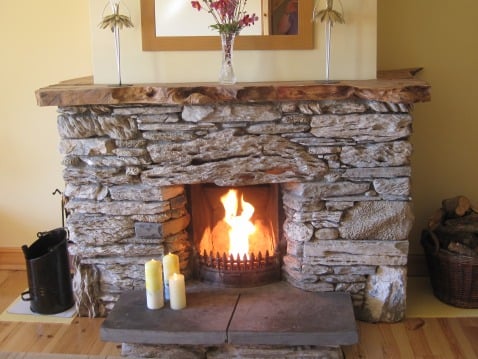A fireplace can be used to generate heat or provide an aesthetic focal point. For years, the only material that was burned in them was wood. Now though, they come in unique styles and consume various types of combustible materials.
The Traditional Fireplace
Most people are familiar with traditional fireplaces. A firebox in the wall is surrounded by bricks and a mantle. Logs are placed inside of a traditional fireplace on a metal grate. Lighter fluid, small kindling, bunched up newspapers or some other type of starter is placed on the logs and lit. A metal or glass screen protects the room outside of the fireplace from flying sparks, popping wood or lit embers. This type of fireplace is often built when a home is first being constructed.
Wood Burning Stoves
A wood burning stove uses small pieces of wood as a combustible. These pellets are created to burn more efficiently, use less wood and release a safer form of exhaust into the air. These stoves are highly efficient in what they do. Tightly sealed, the pellets burn at a slow rate, which also minimizes smoke. Most units are created with cast-iron or welded plate steel.
Prefabricated Fireplaces
Traditionally, fireplaces have been built piece by piece using concrete, bricks, metal and wood. To make installation easier, prefabricated fireplaces have been designed to take their place. Constructed of metal shells and bricks, prefabricated fireplaces simply install into their designated spots.
Gas Burning Fireplaces
Gas burning stoves offer an efficient source of heat. They use propane and natural gas as combustibles and are sealed behind glass. Venting choices for these gas burning units are available in different types and depend on an oxygen source that comes from inside of a room or from the outside. The vent free models can be placed in almost any room and have a shutoff valve that stops gas flow if the unit detects a low amount of oxygen. Direct vent models bring in air from outside and expel exhaust out of a separate pipe. A top vent model uses oxygen from the inside room and expels its exhaust outside.
Fireplace Inserts
Fireplace inserts offer a convenient way to use your current hearth. Created with cast-iron and sealed glass, they are installed inside of the firebox. The cast-iron shell ensures that heat is expelled into the room and not into the surrounding masonry. To work properly, a chimney liner is connected to the unit and vented to the outside.

